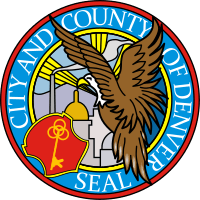Kirkland Museum of Fine & Decorative Art
Kirkland Museum of Fine & Decorative Art is an art museum in Denver, Colorado. The museum houses three principal collections and includes the original school and studio of artist Vance Kirkland (1904–1981). The museum is temporarily closed to visitors to relocate to a new building at 12th Avenue and Bannock Street, opening fall 2017. The 1911 Arts & Crafts style building is listed as a member of Historic Artists’ Homes and Studios, a program of the National Trust for Historic Preservation, along with the homes and studios of Jackson Pollock/Lee Krasner, Charles Russell, Georgia O'Keeffe, Thomas Hart Benton, Charles Burchfield, N. C. Wyeth, Grant Wood and others.[1]
History
Vance Kirkland’s original school/studio (1910–1911), which is preserved as part of the larger Kirkland Museum, is the oldest commercial art building in Denver and the second oldest in Colorado (after the Van Briggle Memorial Pottery in Colorado Springs of 1908).[2] The building was designed in a distinctive Arts & Crafts style by architects Maurice Biscoe (1871–1953) and Henry Hewitt (1875–1926). The building at 1311 Pearl Street was commissioned by Henry Read (1851–1935), one of 13 founders of the Denver Artists' Club, which later became the Denver Art Association (1917) and then the Denver Art Museum (1923). This building served as Read's Students' School of Art. Kirkland recounted that Read and other members used their homes and the Pearl Street building for meetings of the Denver Artists’ Club from 1911 until 1922 when this organization was deeded Chappell House (1300 Logan, razed 1970).[3]
In January 1929, Vance Kirkland became the Founding Director of the current School of Art at the University of Denver. In 1932 he resigned from the University of Denver when they would not grant credit for art courses toward graduation, and leased Read's Pearl Street property. He ran the Kirkland School of Art until 1946, with classes accredited by the University of Colorado (1933–1946), when he returned as Director of the Art School at the University of Denver, retiring in 1969.[4] Kirkland had, by that time, purchased the 1311 Pearl Street building[5] and used it as his personal painting studio until his death in 1981.
After his death, Vance Kirkland willed his estate to longtime family friend Hugh Grant. In 1998, under the direction of Grant, construction began on an adjoining facility, adding 8,830 square feet to the original studio. Completed in 2000, the addition allowed for expanded exhibition space and visitor amenities, while maintaining the integrity of the original studio. The museum opened to the public in April 2003 under Founding Director and Curator Hugh Grant. On May 2, 2016, the museum temporarily closed to visitors to prepare to relocate to 12th Avenue and Bannock Street.
Collections
The museum houses three primary collections: an international decorative arts collection, a regional collection with a focus on Colorado art, and a retrospective of the work of Vance Kirkland. At the museum’s original location at 1311 Pearl Street 3,500 decorative art pieces and 400 paintings and sculptures were on view. The new building at 12th Avenue and Bannock will provide for about 65% more display space and the salon style will be replicated in the new museum.
(1) International Decorative Arts Collection: Includes notable examples from the decorative art movements of Arts & Crafts, Aesthetic, Art Nouveau, Glasgow Style, Wiener Werkstätte, De Stijl, Bauhaus, Art Deco, Modern, Pop Art, and Postmodern. The collection focuses on objects from c. 1875 to 1990. According to scholars, including Patricia Kane, Curator of American Decorative Arts at Yale University, “Nowhere else in the country can one see such a comprehensive presentation of international 20th century design.”[6] Peter Loughrey, Director Los Angeles Modern Auction, similarly stated, “I believe your museum has the finest survey of 20th century design on view in America today.”[7]
(2) Colorado/Regional Collection: This collection includes about 6,000 works by more than 600 Colorado artists. Kirkland Museum preserves the history of Colorado art from traditional through modern, from 1820 to about 1990, with an emphasis on the 1850s onward. Two Denver art critics have said: “…the Kirkland became the state’s most important repository of Colorado art."[8] “…the Kirkland has quickly become the largest repository of such Colorado work anywhere.”[9]
(3) Kirkland Retrospective: Vance Kirkland (1904–1981) painted over 1,200 paintings, with works spanning 55 years, ranging from Realism to Surrealism to Abstract Expressionism to his later abstraction. [10][11] A rotating selection of all five of Kirkland’s painting periods is shown, including his idiosyncratic late dot paintings.[12] Kirkland’s paintings have been widely exhibited at 70 museums and 30 universities in 13 countries and 32 states.[13][14] A one-hour television documentary, Vance Kirkland’s Visual Language—with seven curators and directors from five American museums—was aired on PBS stations from 1994—1996.[15]
Different Display Approach
The three collections make Kirkland Museum different from other museums. The unusual way they were displayed at the museum’s original location at 1311 Pearl Street gave the visitor an alternative museum experience. That display style, explained in more depth below, will be replicated in the new museum on Bannock Street.
(a) Most large city museums are displayed more sparsely than the Kirkland, and decorative art and fine art are usually shown in separate rooms. Kirkland Museum is arranged “salon style” much like a home where—similar to the Barnes Foundation (Philadelphia), the Isabella Stewart Gardner Museum (Boston), the Neue Galerie (NYC), and a few others—fine and decorative art are exhibited together.
(b) In addition to paintings and sculpture being displayed together with furniture, groupings or vignettes are often arranged to showcase a particular design period such as Art Deco. Furniture is frequently accessorized with period radios, phones, lamps and other items. Many museums display furniture on risers, but furniture was never meant to be on risers, so most furniture is placed on the floor at the Kirkland.
(c) Another exhibition characteristic of the Kirkland is “comparative display” where more than one design style is shown in the same gallery. This has been particularly helpful to college classes, allowing students to compare Arts & Crafts, Art Nouveau, Glasgow Style and Wiener Werkstätte in the same room for instance.[16]
Museum Information
Kirkland Museum is building a new facility and relocating to 12th Avenue and Bannock Street in Denver's Golden Triangle Museum District. The new 38,500 square foot building, designed by Seattle-based Olson Kundig, is projected to open in fall 2017.
Vance Kirkland’s original school/studio building is the heart of the Kirkland Museum experience. The three-room Arts & Crafts structure will be relocated to Bannock Street and oriented in the same direction.
References
- ↑ National Trust for Historic Preservation. "Historic Artists' Homes and Studios".
- ↑ Nelson, Scott H. (1986). A Collector's Guide to Van Briggle Pottery. p. 38.
- ↑ McComb, David (1975). Interview with Vance Kirkland. Denver, CO: Colorado Historical Society Archives.
- ↑ Denver Art Museum Catalogue (1978). Vance Kirkland: Fifty Years. Denver, CO. p. 41.
- ↑ McComb 1975
- ↑ Kane, Patricia (2005). personal letter to Kirkland Museum.
- ↑ Loughrey, Peter (2003). email to Kirkland Museum.
- ↑ Paglia, Michael (March 4, 2010). "Centennial State". Westword.
- ↑ MacMillan, Kyle (February 7, 2010). "100 Years of Colorado Art, Visual Movements in History". The Denver Post.
- ↑ Fitz, Peter (1997). Vance Kirkland-A Painter from Denver. Hungary: Kiscelli Muzeum/Budapest History Museum. p. 9.
- ↑ Koenig, Dr. Wieland and Dr. Evelyn Weiss (1999). Vance Kirkland (Exhibition Catalogue ed.). Dusseldorf, Germany: Stadtmuseum. p. 12.
- ↑ Koenig, Dr. Wieland and Dr. Evelyn Weiss (1999). Vance Kirkland (Exhibition Catalogue ed.). Dusseldorf, Germany: Stadtmuseum. p. 13.
- ↑ Vanderlip, Dianne Perry and Peter Weiermair (1998). Vance Kirkland. Zurich and New York: Edition Stemmle. pp. 153–7.
- ↑ Andreeva, Ekaterina and Hugh Grant (2000). Vance Kirkland Retrospective (Exhibition Catalogue ed.). St. Petersburg, Russia: The State Russian Museum. pp. 220–230.
- ↑ Rocky Mountain PBS, KRMA-TV. Denver, CO: Emmerich Oross, Director. 1994.
- ↑ Grant, Hugh (March 30, 2010). Bard Graduate Center Lecture. New York, NY.
External links
- Kirkland Museum of Fine & Decorative Art official site
- National Trust for Historic Preservation: Historic Artists' Homes and Studios - The Kirkland Museum

